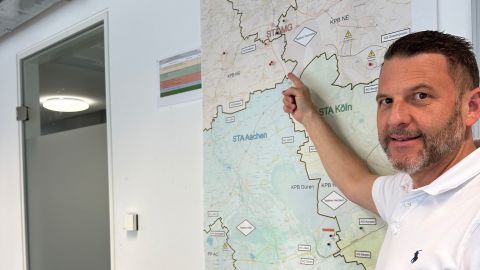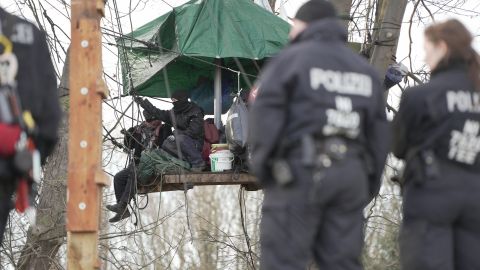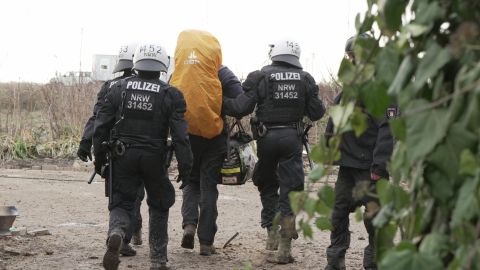The task of the investigation commission was to investigate crimes that had taken place during the eviction and the subsequent gatherings and to shed light on the left-wing extremist scene.
"Lützi stays!" is the message on the many yellow banners and signs. Some have come to Aachen police headquarters as evidence from the formerly occupied hamlet of Lützerath. This is where the Hambach Investigation Commission of the State Security Criminal Investigation Department works.
In January 2023, the North Rhine-Westphalia police cleared the small village of Lützerath in the Rhenish lignite mining area in five days. "I suspected it would be quick, but I didn't expect it to happen so quickly," recalls Chief Inspector Alexander Maaßen. He should know. He has been dealing with the occupations in Hambach Forest since 2016, has also been deployed in Dannenröder Forest and Leipzig to advise on operations and most recently assisted in the evacuation of Lützerath.
"Lützi" has therefore not remained. Even Google Maps no longer shows the location. But 60 kilometers to the west in Aachen, just a few days after the eviction, the Lützerath Investigation Commission of the same name was founded.
Criminal Superintendent Bartke and Chief Superintendent Maaßen are long-standing members of the Hambach Investigation Commission, which was set up on February 1, 2016 due to the increasing number of crimes committed in the Rhenish lignite mining area. "Whether it's an excavator occupation or a tripod - in Aachen, we are very familiar with every form of occupation and climate protest. After our experiences in Hambach Forest, we knew who we were dealing with," says the 51-year-old.
He has been in the police force since 1996, grew up on Rhenish brown coal himself and lives very close to Hambach Forest. Maaßen was responsible for the investigations section of the Lützerath Investigation Commission, which was led by the head of the State Security Criminal Investigation Department. Today, he heads the Hambach Investigation Commission and knows: "The police protect peaceful protests. But some of the scenes we saw during the eviction had nothing to do with that. Lützerath was partly instrumentalized by militant left-wing autonomists for their own purposes. It wasn't about climate protection. We already knew these people from previous operations. They weren't just weekend tourists who came to the Rhineland to demonstrate. And the deeper you investigate, the more criminal energy you find," commented Maassen.
The EK began its work after leaving Lützerath at a depth of 11 meters. The task was to investigate criminal acts that had taken place during the evacuation and the subsequent gatherings. The aim was also to convict violent climate activists and shed further light on the links to the left-wing extremist scene.
The eviction was not all peaceful. The police operation had been prepared for months. Hundreds of police from all over Germany came to the Rhenish lignite mining area to provide support. Violence broke out on the fourth day of the eviction. Police lines were broken through. Several hundred demonstrators attempted to storm Lützerath. 46 police officers were injured as a result of external influences.
Alexander Maassen sums up: "The level of violence towards our colleagues was exceptionally high. There were firecrackers and pyrotechnics thrown, but also physical attacks with objects such as iron bars and the like. In this respect, we were highly motivated in our investigations to bring the perpetrators out of anonymity. We also did this for our colleagues out there."
Bartke was at the scene himself that day: "I remember January 14 and the threatening scenario very well. You could hear from afar how a large crowd of people stormed towards Lützerath, screaming. The background noise was frightening. The colleagues deployed had to go to their limits for hours, and sometimes even beyond, to prevent Lützerath from being stormed."
Criminal Superintendent Bartke is known by her colleagues in Saxony as the "recognizer". The North Rhine-Westphalia police, on the other hand, are a little more sober. Here she is a case officer who recognizes criminals and their faces. In the meantime, she has developed her very own approach. "The last thing I always look at is the ears. Whether it's piercings or colorful hair, no matter how a person's appearance changes, their ears don't change," she explains. She and her colleagues are supported by facial recognition software.
"But even that reaches its limit at times. Sometimes I recognize things that the software cannot. The human and digital brain have to complement each other in a meaningful way. Even the best program is only as good as the person operating it. But above all, it makes work much easier," notes Bartke. "We feed the program with the image and video material that we have. And then we upload the search image to find the person. When I have a match, I look at the report and see how plausible the match is. If the hits match, I make an identification note," explains Bartke.
In addition to the yellow banners and signs, the police also brought 3.4 terabytes of image and video material with them from Lützerath. That's more than 100 hours of video material that had to be viewed. The police footage from the operation was supplemented by freely accessible videos and photos from social media. There were also interviews with victims and witnesses from all over Germany. Evaluating this required effort, time and a great deal of passion.
The biggest challenge was to assign the digital results of the evaluation to the witness statements and a specific set of facts. Is this specific crime what you see on the video? Where did it happen? When and where was the evidence recovery unit on the site? Do I see any other crimes on the video sequence? The detective superintendent summarizes: "You have to bring the crime and the video together. And then we continue with the written work."
The Hambach Crime Investigation Unit, which has been in existence since February 2016, and most recently the Lützerath Crime Investigation Unit, are like a separate department within Aachen Police Headquarters. Investigations are conducted here using maps of the Rhenish lignite mining area, between shelves of files and with modern technology. The exchange of information with other state security services is important for successful investigations - both nationally and internationally.
The Aachen EK is in regular contact with colleagues in France. Most recently because of investigations into the so-called "Monk of Lützerath", who gained notoriety through a video of the eviction that was shared thousands of times on social media. He pushed a police officer who had got his foot stuck in the mud to the ground. The person in the monk's habit was a young man who was already known from the G20 summit in Hamburg. The man is also no stranger to the French police. He has already been convicted of a similar crime in France. The Mönchengladbach public prosecutor's office has now initiated proceedings for assault against law enforcement officers. The proceedings are still ongoing.
Maaßen emphasizes: "We know the people. We have a nationwide view of the climate activist scene here in Aachen. We now provide supra-regional support and are happy to pass on our knowledge of operations and investigations. We recently received an inquiry from Brandenburg. Disturbers had gone on the rampage on the Tesla site. These are also protagonists who are not unknown to us."
What did EK Lützerath do with the huge amount of data? 594 criminal charges, 281 identified suspects. The clearance rate is also impressive at 26 percent. And the trend is rising. The investigations are continuing. In many cases, the perpetrators were masked and the video footage was not always clear enough to identify the individuals immediately. Maaßen is certain: "Not only have we done a damn good job, we have also done ideal preparatory work for similar operations in the future. And there will undoubtedly be similar missions in the future."
Lützerath is certainly a small part of the history of the Rhenish lignite mining area. But what Lützerath is also: a successful police operation and an investigative commission that knows how to do it.
Aachen Police Headquarters
What remains of Lützerath


